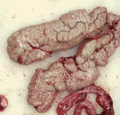Gonad: Difference between revisions
CSV import |
No edit summary |
||
| (One intermediate revision by the same user not shown) | |||
| Line 36: | Line 36: | ||
{{stub}} | {{stub}} | ||
==Gonad== | |||
<gallery> | |||
File:Ovaries_of_Cyprinus_carpio.png|Ovaries of Cyprinus carpio | |||
</gallery> | |||
Latest revision as of 23:33, 16 March 2025
Gonad
The gonad is an organ that makes the cells used in producing babies. In males, these organs are the testes; in females, they are the ovaries. They are a part of the reproductive system.
Function[edit]
The primary function of the gonad is the production of gametes, or sex cells, and hormones. In males, the gonads produce sperm and male sex hormones. In females, the gonads produce eggs and female sex hormones.
Male Gonads[edit]
In males, the gonads, known as the testes, are located in the scrotum. They produce sperm and the male sex hormone, testosterone. Testosterone is responsible for the development of secondary sexual characteristics during puberty, such as increased muscle and bone mass, and the growth of body hair.
Female Gonads[edit]
In females, the gonads, known as the ovaries, are located in the pelvic cavity. They produce eggs, or ova, and the female sex hormones, estrogen and progesterone. Estrogen is responsible for the development of secondary sexual characteristics during puberty, such as the development of breasts and the start of menstruation. Progesterone is involved in the menstrual cycle and pregnancy.
Disorders of the Gonads[edit]
Disorders of the gonads can lead to a variety of health problems, including infertility, hormonal imbalances, and cancer. Some common disorders include Polycystic Ovary Syndrome (PCOS), testicular cancer, and ovarian cancer.
See Also[edit]
References[edit]
<references />



